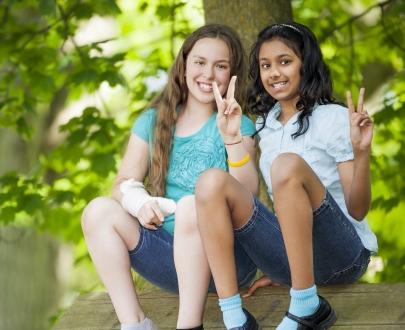 Children and youth who are “peacemakers” are better able to solve problems, get along with others and create a positive atmosphere. This is not about avoiding conflict entirely (that is not possible), or being compliant, disengaged or coerced into behaving a certain way. Solving problems peacefully means using empathy, understanding other points of view and actively coming up with strategies to make things right in a fair way, while respecting others and themselves. Specifically, research[1] outlines listening skills, the ability to communicate feelings and problem solving skills as fundamental in solving problems peacefully among peers.
Children and youth who are “peacemakers” are better able to solve problems, get along with others and create a positive atmosphere. This is not about avoiding conflict entirely (that is not possible), or being compliant, disengaged or coerced into behaving a certain way. Solving problems peacefully means using empathy, understanding other points of view and actively coming up with strategies to make things right in a fair way, while respecting others and themselves. Specifically, research[1] outlines listening skills, the ability to communicate feelings and problem solving skills as fundamental in solving problems peacefully among peers.
A peaceful classroom is invaluable to both educator and students. It makes it possible for teachers to teach and students to learn. You can use the following three approaches as an audit - to reflect on the peacemaking habits in your classroom.
1. Create a space and emotional environment that will have universal impact.
- Introduce language to describe abstract concepts such as the greater good, interconnectedness and belonging.
- Tell positive stories about students, teachers and the school. Stories are symbolic and influence what students use to define social status.
- Display positive images[2] representing getting along with others.
- Post clear rules, expectations and responsibilities for students.
2. Explicitly teach positive communication strategies to build a repertoire of easily accessible skills.
How well do students already apply the following:
- Positive self-talk in journalling
- Active listening techniques
- The use of “I”-messages[3]
- Identification and understanding of the differences in conflict styles
- Restorative justice[4] processes (Does your school commit to these practices when unkind behaviours occur?)
3. Engage in activities that integrate strategies and develop peaceful habits of mind.
- Deep breathing[5] - an easy, accessible but often over-looked strategy for anxiety prevention, conflict resolution and self-regulation
- Use role plays to practice peacemaking skills
- Host a Diversity Panel[6]
- Hold regular class meetings, circles[7] or other opportunities for students to participate and provide input
Peaceful Classrooms pay off in many ways!
A 4-year study[8] in schools situated in high crime neighbourhoods showed that focusing on creating an environment that felt safe and “violence free” had significant impacts on behaviour incidents, school attendance, grades, graduation rates and perception of positive school climate. The researchers calculated the return on investment as a savings of $8 for every $1 spent creating the environment and promoting the skills in middle and high schools. The long term savings came from costs from school administrative, police, automobile thefts, and juvenile detention.
In a study publised in 1994, researchers Philip Morse and Ron Andrea examined peer mediation and identified the skills that were found to be effective.
Researchers tested whether showing infants visual suggestions of human connection (using posters of dolls facing each other or not) would have an impact on the child's (unrelated) helping behaviour. Results demonstrated that priming children using pictures in the environment does influence positive behaviour.
"I" Messages are statements that focus on the speaker's reaction to another person's behaviour without making judgements.
Effective "I" statements describe the other person's behaviour, includes the speaker's interpretation and feelings and outlines any consequenses of the behaviour on the speaker.
E.g. "I felt anxious and angry that I was late when I didn't get a ride with you to school after we had agreed to go together."
Restorative Justice is a process that puts the onus not on punitive measures, but on addressing the needs of the victims.
"It represents a return of the simple wisdom of viewing conflict as an opportunity for a community to learn and grow. It operates on the premise that conflict, even criminal conflict, inflicts harm, and therefore individuals must accept responsibility for repairing that harm." (The Centre for Restorative Justice, SFU)
Deep, calm breaths can slow your heart rate, lower your blood pressure and even sharpen your focus. Breathing as part of an intentional strategy to be mindful has even been found to improve impulse control in teenagers by giving time and space for a perspective check.
Diversity Panels bring together a diverse group of people to acknowledge and share different perspectives and experiences on a topic. The process helps widen our understanding of each other and the world.
Circle Sharing can encourage students to feel secure and calm. Heart-Mind Online offers more ideas on how to use them in the classroom.
A study (2007-2010) of middle and high schools in an urban center, discovered that designating schools as "violence free" resulted in:
44% decrease in behaviour
79% decrease in suspensions
23% decrease in truancy
9.3% increase in GPA
24% increase in graduation rate
64% increase in students report on positive school climate